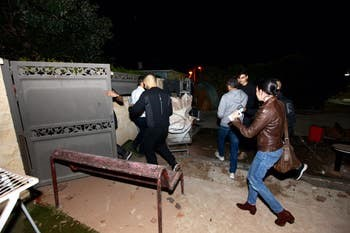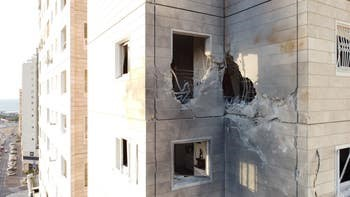The Marker, Adi Cohen, Gili Melnitsky, 12.05.2021
More than 60% of the apartments in Israel do not have a security room, according to recent data from the Association of Builders in Israel, which examined the condition of sheltered housing in Israel. 27% of Israeli residents (about 2.4 million people) do not have access to standard protection space. According to the Home Front Command, the largest number of apartments exposed to security threats without an attached security room is in the Central and Tel Aviv districts - with more than 400,000 apartments without security guards.
The Tel Aviv district is a leader, with a share of about 75% of the residents living in apartments without security in their territory. Among Israeli cities, the highest number of apartments without security in their territory is in Jerusalem - with close to 180,000 unprotected apartments, followed by Tel Aviv , Haifa, Petah Tikva, Rishon Lezion, Beer Sheva, Netanya and Ashdod.
Home Front Command data show that for those who do not have a security guard at home, spatial public shelters manage to respond to only 6% of the Israeli population, and shelters in the building respond to 28% of the country's residents. More than a quarter of Israeli citizens are exposed to missiles. Dedicated, as recommended by the guidelines.
Data from the Urban Renewal Authority and government ministries show that NAP 38 - the national master plan for the protection of buildings against earthquakes, which was approved in 2005 as one of the main solutions to the issue of building protection in Israel - has so far not yielded the desired results.
Of the approximately 800,000 dwellings that comply with the TAMA conditions and were built before 1980, only 115,000 dwellings are in various planning, execution and occupancy processes. An additional 600,000 dwellings have no economic feasibility for implementing building reinforcement plans without significant government intervention by the government.
The writing was on the wall
It seems that the government ministries were well aware that hundreds of thousands of residents would be left unanswered on the protection issues - since the writing was on the wall. The explosive security reality in Israel has over the years led to the formulation of a series of government decisions and plans designed to strengthen the protection system to strengthen the protection system of housing spaces and public institutions.
However, the State Comptroller's reports repeatedly pointed out significant deficiencies in the home front's deployment, which could increase the risk to the lives of the population during times of war.
For example, the latest report on the subject, published in August 2020, states that about 2.6 million Israelis do not currently have standard protection in their living space. 232,000 of them live within a range of up to 40 km from the Gaza Strip, and 614,000 residents in the range Identical to Israel's borders with Lebanon and Syria. The situation is also alarming in public shelters - 16% of public shelters are not qualified at all, and 33% are at a low level of competence.
An earlier report by the State Comptroller from 2016 - two years after the end of Operation Eitan - also found significant deficiencies in the home front's in terms of protecting residential buildings and public institutions, resulting from non-coordination between the various parties involved; An overall picture of the actual protection status.

Netivot residents flee to a protected area during an alarm. Government assistance to improve protection in the periphery, reluctant to come Photo: Eliyahu Hershkovitz
The auditor's reports refer to several government decisions made between 2013 and 2018 - most of which did not mature into action. The first of which is a government decision from 2013, in which an inter-ministerial team was set up, headed by Gilad Ardan.
The team recommended, among other things, that construction of security units be built in buildings that do not meet Home Front Command standards.
The budget for the implementation of the plan was estimated at NIS 10 billion. However, in 2016, according to the auditor's report, the plan was buried by the Prime Minister's Office, which claimed that it was expected to have negative economic consequences for the construction industry, real estate and credit markets, and housing prices in the country. Instead of requiring the construction of MMADs, the government has chosen to focus on removing barriers and shortening processes for their construction - while finding facilitative financing solutions for peripheral areas.
In September 2014, the government decided: "To impose on the Director General of the Ministry of Construction and Housing and the head of the National Emergency Authority, in coordination with the Accountant General and the Budget Minister in the Ministry of Finance, the Attorney General and the Director of the Interior Ministry." "Dimensions and other protection solutions in residential homes."
The team was supposed to formulate the plan by January 2015, but its work was delayed following the dissolution of the 19th Knesset. In July 2016, the recommendations were forwarded to the Prime Minister’s Office, raising dust for months. When they were presented to the government only at the end of 2017 - no budgetary resources were allocated to implement most of the decisions made. Later, in discussions held in early 2018, officials in the Ministry of Housing explained that the budget department in the Ministry of Finance opposes the definition of the MMAD as the leading protection solution, in favor of cheaper protection solutions.

In 2018, the task of improving protection was again placed on the government table, following a five-year plan formulated by the Home Front Command for civil defense in the northern and southern districts. For the implementation of the plan, and subject to the Cabinet decision, an inter-ministerial team was formed - involving the National Security Council, the Ministry of Defense, the Ministry of Finance, the Home Front Command and the Ministry of Construction and Housing.
At the same time, the Cabinet instructed the Ministries of Finance and Defense to indicate an immediate budget source of NIS 500 million for 2019-2018, for the purpose of protecting public institutions and residential buildings. Due to disputes that arose between the Ministries of Finance and Defense, only a partial budget of NIS 300 million has been approved so far.
The Ministry of Housing claims in response that in recent government decisions on the subject, which mainly concerned the protection of residential buildings in the south, "the ministry acted to protect 10,470 apartments in 44 localities in Sha'ar Hanegev, Sdot Negev, Ashkelon, Eshkol Beach and Sderot, "Implemented in full. These government decisions were implemented between 2008 and 2017 until the end of the budget allocated for the ministry's activities there."
The failure of TAMA 38
In his recent reports, the State Comptroller also referred to the government's decisions since 2005 - to reduce the protection gaps in buildings built before 1992. Those decisions were not implemented at all or were only partially implemented - especially in the periphery.
NOP 38 - the national master plan for strengthening existing buildings against earthquakes, which came into force in 2005 - includes the receipt of building rights in exchange for the addition of dimensions. According to data from the Urban Renewal Authority, only about 15,000 apartments have been strengthened and protected to date under the plan. An additional 100,000 are currently in the planning stages or under construction.

A building damaged in Ashkelon in the last round of fighting Photo: Ofer Vaknin
Precisely in the peripheral areas, including those near the borders, the implementation of the plan is poor - due to the inefficiency of implementing it in places where the value of the land is low. According to data from the Urban Renewal Authority, only one building in Ashkelon received a permit under TMA 38; in Kiryat Gat three; in Kiryat Malachi one; and in Gedera three buildings.
Ashdod is the only one of the southern cities that manages to stand out with a volume of 334 buildings that received TMA permits, especially in the ultra-Orthodox districts. The high land values in Tel Aviv allowed more than 1,268 buildings to receive permits for TMA 38.
It seems that the main beneficiaries of the plan are the developers and apartment owners in the center who have managed to improve their properties, and not the tenants in the vicinity of the border lines and the Syrian-African rift that are in greater danger.

Raul Srugo, President of the Contractors Association: "We call on the government to immediately extend the validity of NAP 38"Photo: Eyal Toug
About 400,000 apartments without security rooms fall between the chairs without being able to improve protection through NAP 38. The law requiring the construction of security rooms in residential apartments was passed only in 1992, but the master plan only applies to apartments built before 1980.
NAP 38 is expected to expire in October 2022, and the government has not yet decided on the mechanism that will replace it. 38 next year - as determined by the director of planning and as many mayors are already doing in practice, "said the president of the Builders Association of Builders, Raul Srugo.
According to him, the government's announcement of the abolition of the NPA, "led to a halt in the protection of old houses in the center of the country - in addition to dragging the feet of governments for years, which did not create a workable protection plan for houses in the periphery.

Elazar Bamberger, Director of the Urban Renewal Authority: "We also operate in the periphery and protect the tenants in the foreseeable future."Photo: Emil Salman
"We call on the government to immediately extend, for an indefinite period of time, the validity of NAP 38 until it is replaced by another alternative, and to require mayors to approve permits accordingly, while financially supporting the development of the necessary infrastructure. This round of missiles proves to us once again that life Themselves precede all. "
In response to Srugo's remarks, senior planning officials told TheMarker that "this is a cynical statement, as the contractors are well aware that NAP 38 has failed precisely because it did not provide protection in peripheral localities. In contrast, it has been implemented mostly in the center of the country, where it is economically viable for contractors. In order to provide protection for the periphery, another solution must be found and not continue in NAP 38, and replace the existing mechanism with more appropriate tools for the neighborhood and the city. "
Elazar Bamberger, director of the Government Authority for Urban Renewal, said: "Urban renewal is an optimal solution - in the form of new buildings that are built according to strict protection standards and include security. This has been evident in recent years through dozens of urban renewal projects carried out in the central region. The government authority is also working in a number of peripheral cities to carry out urban renewal, and to protect the tenants in the foreseeable future. "
The Home Front Command did not fulfill its role
Unsurprisingly, the situation in Arab localities is worse. The Arab authorities, which suffer from old infrastructure and many construction defects due to illegal construction in the absence of appropriate plans, are not prepared even in case of missile strike.
According to the State Comptroller's report, as of the end of 2017, about 46% of the residents in the non-Jewish sector (about 550,000 residents) do not have access to any kind of standard protection. Authorities like Umm al-Fahm, Majd al-Krum and Nazareth did not even have Basic information on the number of unprotected residents in their area.
70 of the 71 Arab local authorities surveyed do not have a municipal by-law that requires shelters in residential buildings. 28% of students in the non-Jewish sector do not have standard protection in educational institutions. In some institutions there is no protected area at all.
The auditor noted that most of the defects have existed since 2007 and have not been repaired since. In addition, the Home Front Command did not fulfill its role in carrying out the necessary actions to ensure protected areas in non-Jewish localities.
According to Home Front Command estimates from 2016, while among the Jewish population close to 100% of the population in localities located up to 9 km from the border, it is protected.
Among the Arab population in this range, more than 50% are unprotected. At a distance of 20–9 km from the border, about 30% of the Jewish population and about 65% of the Arab population have no protection.



